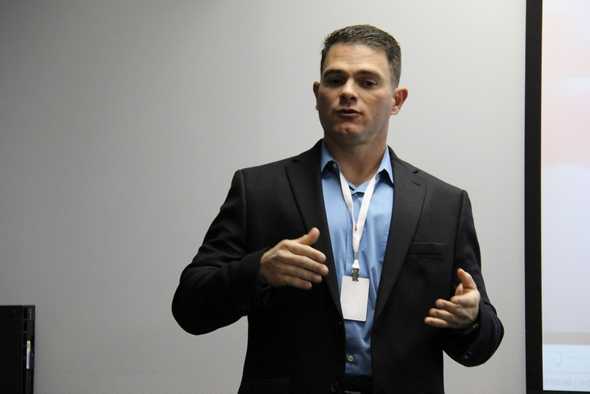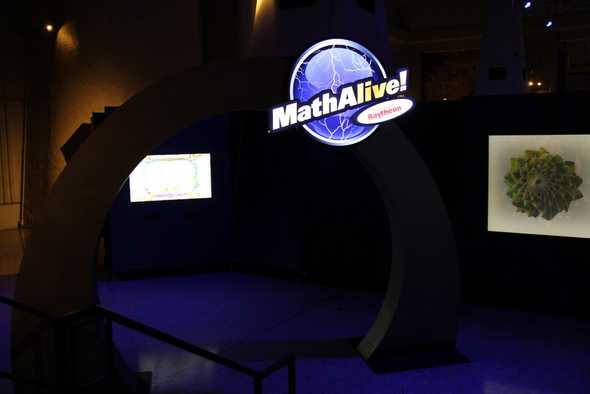Crespo talks about Raytheon's new automated plant
The first speaker at Space Camp’s MathAlive! tweetup in Huntsville, AL was Raytheon Company plant manager Angel Crespo. They are opening a new missile plant in about two weeks and partnering with Missile Defense Agency located at the Redstone Arsenal. They explored more than 23 locations across the country but chose Huntsville for a talented community, easy transportation via: air, water, highway, and rail, and a favorable location for sensitive operations. Construction of the Huntsville plant started in June 2011 and should be completed around Thanksgiving. It will open on November 26th to the public and start operations the following Monday.
Raytheon, a defense contractor, is about 72,000 people strong, divided into six business units, including the Missile Systems unit, which is about 11,000 strong. They do concept, development, prototyping, engineering, detailed design, critical design, manufacturing design, initial manufacturing, manufacturing and test, deployment, maintenance, logistics, and program closeout. Development and research development happens in California and Arizona. They have about 8,000 in Tucson, 5,000 of which are engineers.
The facility is starting with 40 employees and is expected to grow to 90. It is the most automated missile factory in the world. Crespo told us that moving hardware is one of the biggest problems they have. Using robots to do these tasks helps to decrease errors and increase safety. Humans are an element of the automated system, performing “thinking operations” like creating a new product rather than labor intensive tasks. Robots bring the correct parts to a worker, avoiding actions that can result in fatigue or repetitive stress injuries. The system performs data entry and tasks like using a screwdriver to tighten screws.
The system uses 2D QR codes to track parts which are automatically picked, scanned and moved around the facility. This prevents humans from making clerical errors.
For safety reasons, they also took the human element out of testing. Products are automatically tested in what they call a test cell, which provides additional protection in the event something unexpected happens.
The facility will build, integrate, test and recertify Standard Missile 3 and Standard Missile 6 weapons for the Missile Defense System. A critical lift used to take a lot of people and procedures. They have now automated 16 processes in total, allowing hardware to be moved very smoothly and safely without cranes or operators. The system is designed to work alongside human operators. This means the operator can walk beside a machine, but if the operator gets too close, the vehicle will automatically slow down or stop. Similarly, if the operator reaches inside a predetermined “safety perimeter”, the vehicle will stop and shut down.
Crespo compared the speed the vehicles move to walking with a very large slow pet. The vehicles can vary from 10 to 24 feet in length, weighing eight tons. The vehicle can typically carry 8,500 pounds for a total weight of about 25,000 pounds. At about 3 feet from the vehicle, the vehicle can sense a human walking next to it, but will continue normal operations while tracking where the human is. At about two feet between vehicle and human, it will slow down, flash lights, and make sounds warning the human that they are too close. Within a foot, it will stop completely.
One automated vehicle replaces carts that required four people to push. Crepso mentioned that this factory does more for less. It has about the same proportions of humans as other facilities do, but humans are used more for thinking operations instead of manual labor. They use humans for what they are great at, using their brains, in a safer environment.
The factory is equipped with a wifi network that supports the communications between vehicles and operations.
One of the reasons Raytheon chose Huntsville for their next location is that the local community is full of great contractors and people with science and engineering skills that are valuable to the successful operation. With a few training classes, engineers can be trained to be missile technicians.
Crespo said by 2040, the US will only be able to produce 40% of the required engineering workforce. That means there will be a high demand for engineers and scientists that we won’t be producing in our school systems. It isn’t that we don’t have schools or people to solve this. In fact, our educational institutions in the US are world class. Students from other nations come to the US to get their degrees. It is rather a matter of motivating students to choose this career path early in their lives. There needs to be incentives to attract young students to science, math, and engineering careers. Due to national security reasons, allowing non U.S. citizens to have security clearance is not feasible and won’t be a viable source to fulfill the remaining 60%.
Raytheon has already contributed $60 million into the Science, Technology, Engineering, Math (STEM) campaign. The MathAlive! exhibit is Raytheon’s second biggest exhibit they’ve designed for the STEM campaign. The first was Sum of all thrills at Disney’s Epcot theme park. The exhibit will visit about 10 cities in the next three years.
Raytheon has been the platinum sponsor for Math Counts. Crespo was a Math athlete and counselor in elementary school. He mentioned that Math Counts was a critical turning point in personally motivating him to be an engineer. He was enabled to make a relationship between the math concepts he learned and the skills needed to be an engineer.
He told us math is fun. Math can be fun. Science is fun. Science can be fun. We need to incentivize that. The MathAlive! exhibit allows a 6 or 7 year old to walk up to one of the stations and make the relationship between this is the fun part of it and the part where they learn the process to get a result.
Getting a result from an experiment is a thrill. Nearly every engineer will agree that they get a thrill and a rush from getting a result or discovering something new or unexpected. You get addicted to that rush and that’s what we want. It’s a good addiction to have.
Here’s the video of him talking at the tweetup:


